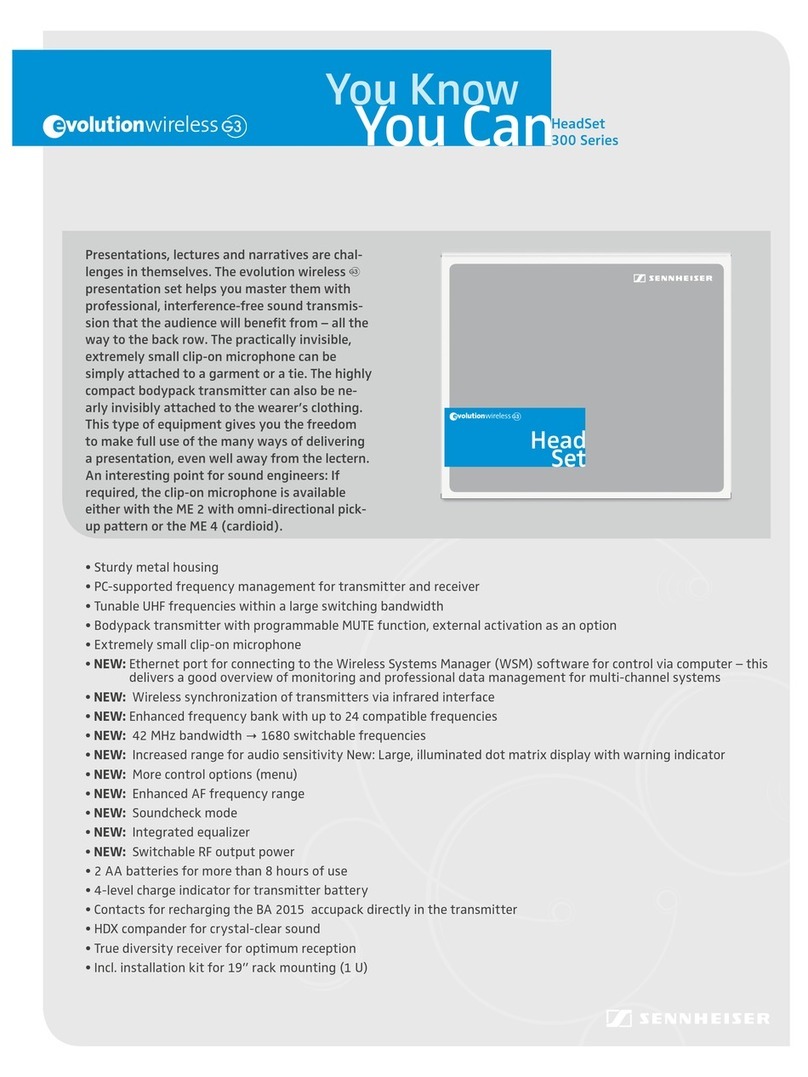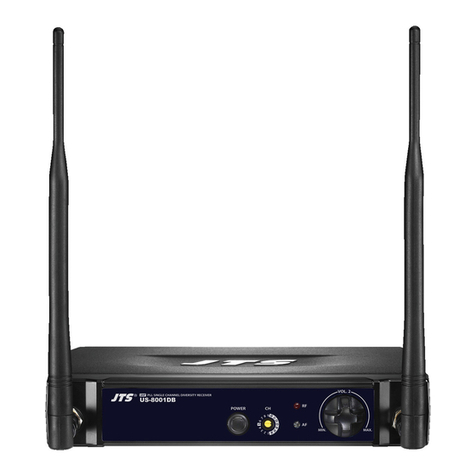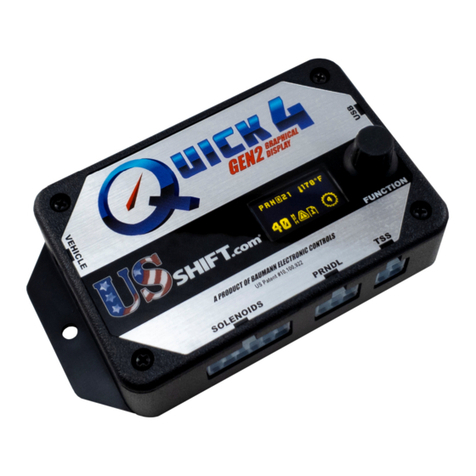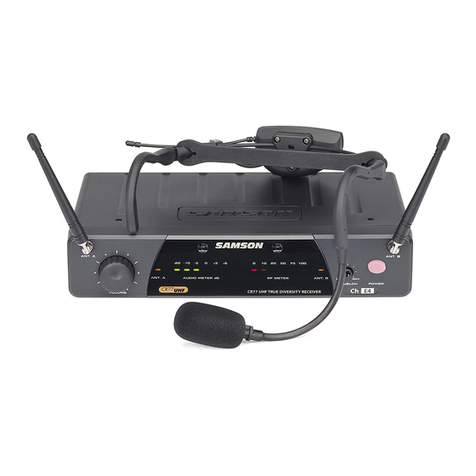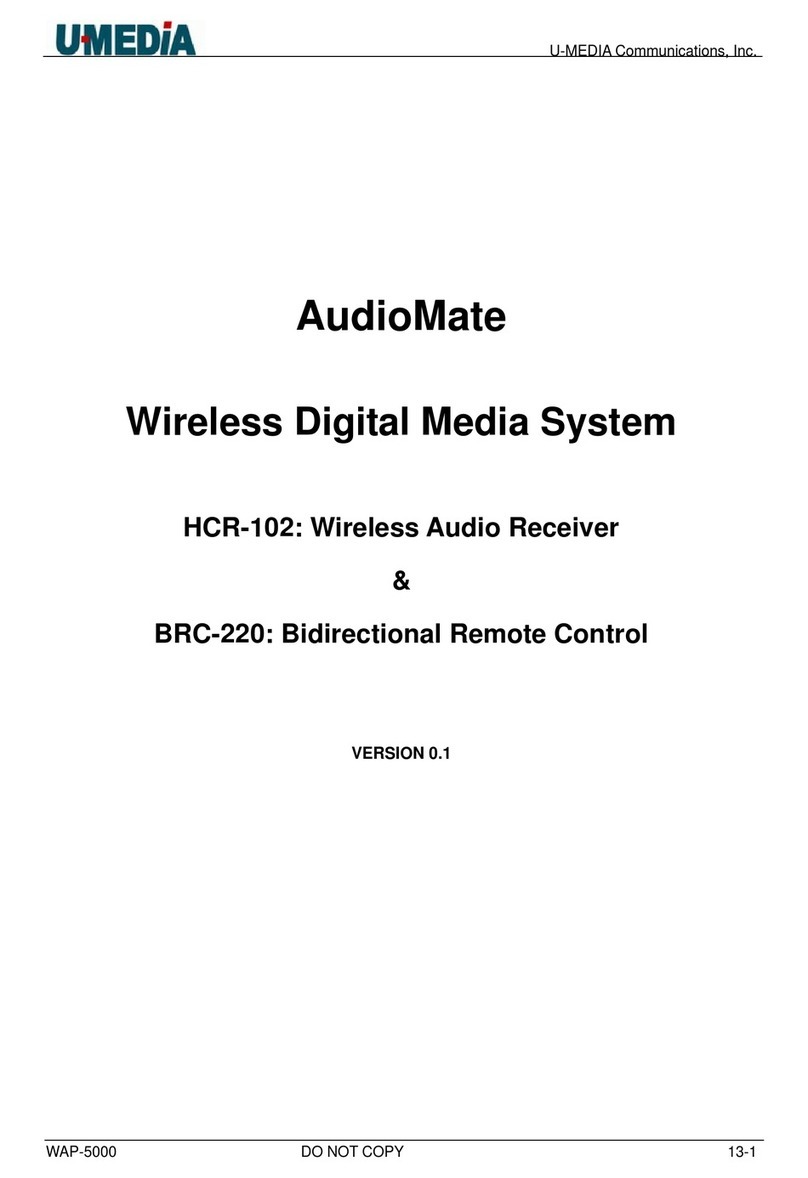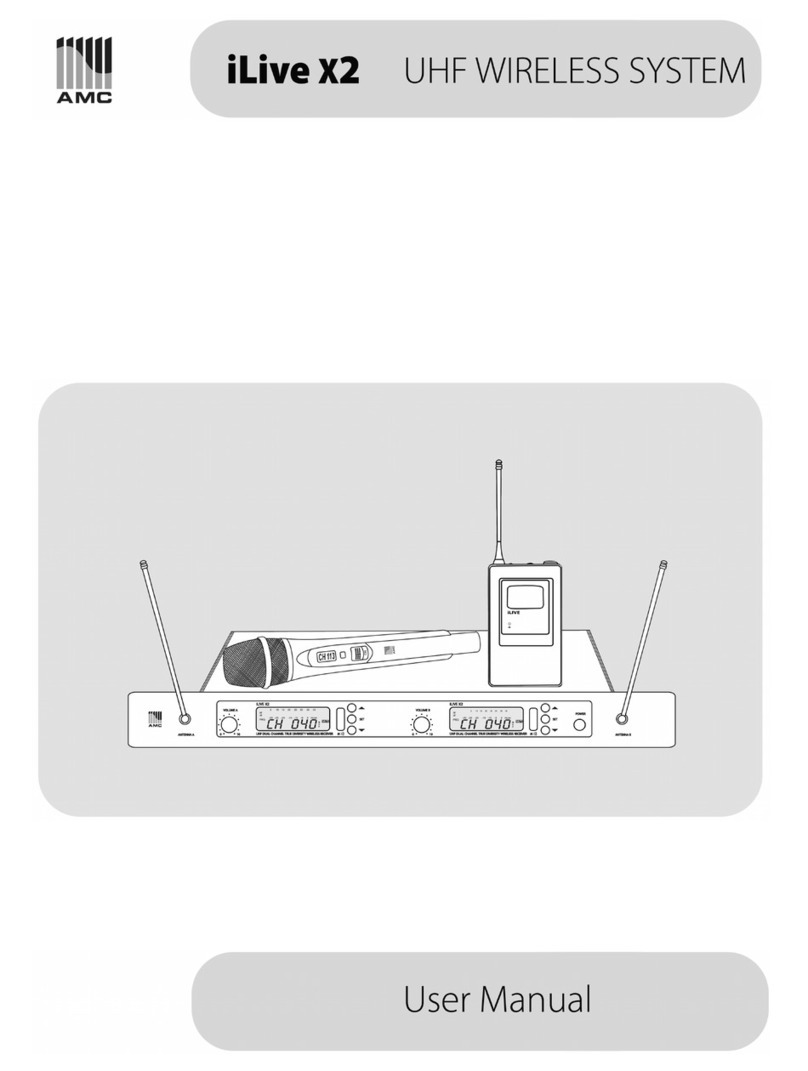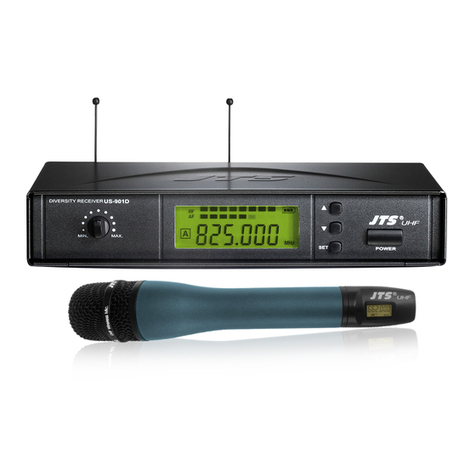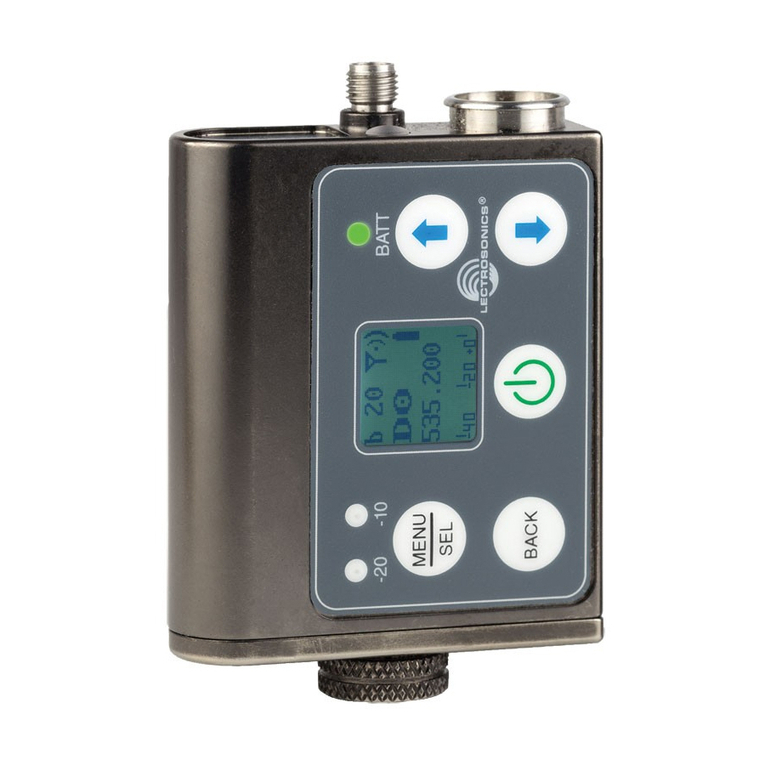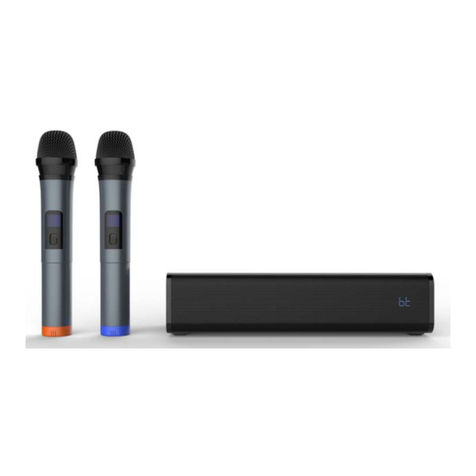Microdot M100 User manual

MMICRODOT
M100
Wireless Microphone
Personal In-ear Monitoring
Interview Camera-Mount Wireless
Operating Instructions
Before operating the unit, please read this manual thoroughly
and retain it for future reference.
MT100 Bodypack Transmitter
MR100 Bodypack Receiver
Uni-directional lavalier microphone
Earphone
Mount adapter
3.5mm - 3.5mm jack plug cable
3.5mm - 6.3mm jack plug cable
XLR - 3.5mm plug cable
Carry case
YPA MICROPHONES INC

Configuration of the Packages
This manual is for the M100 Wireless Microphone Packages. The contents of each package are described below.
The package consists of a body-pack transmitter (MT100), a body-pack receiver (MR100), and their accessories.
Body-pack transmitter
MT100
Body-pack receiver
MR100
Supplied accessories
Uni-directional lavalier microphone (1) Holder clip (1) Wind screen (1) Shoe mount adapter (1) Belt clip (1)
XLR-3.5mm locking conversion output
cable for the MR100 (1)
Mono 3.5mm plug-3.5mm locking plug
conversion cable (1)
6.3mm plug-3.5mm plug
conversion cable (1)
In-ear earphone (1) Carry case (1)
1

Features
The Microdot M100 camera-mount wireless lavalier microphone system features the proven combination of reliability, flexible control, and broadcast-qu-
ality sound for videographers, journalists, and content creators.
They are equipped with a DSP for transmission of highquality sound using digital compander processing.
The M100 gives you the tools to adapt and meet the wireless challenges that inevitably arise on set. The frequency scan function searches for the clea-
nest frequency at your location.
The system includes a cardioid lavalier mic, an earphone, a bodypack transmitter(MT100), and a camera-mount receiver(MR100). It connects to a cam-
corder or a DSLR/mirrorless camera to capture crisp-sounding speech or dialog in noisy environments, for projects ranging from documentaries to wed-
ding videos, corporate spots, and hands-free interviews.the packages can be used for various purposes, such as ENG ( Electronic News Gathering ) ,
EFP (Electronic Field Production) and sports events.
The contents of each package are described below.
Built for Dependable Performance in the Field
The M100 features rugged, metal chassis well suited for extended use on location. The lightweight and compact bodypack transmitter is easy to conceal.
Its rounded edges are soft to the touch making it comfortable to wear for the talent. A locking connector ensures that your lav doesn’t detach at a critical
moment, while a convenient switch allows you to mute your mic.
Using the included shoemount adapter, the equally compact receiver easily mounts on your camera without adding much weight. The included cables a-
llow you to connect the receiver to the 3.5mm or XLR audio input of any DSLR/mirrorless, camcorder, or recording device.
Both transmitter and receiver feature LED displays showing reception quality, battery status, and audio level.
Broadcast-Quality Sound
The M100 ships with a cardioid lavalier microphone, which delivers a natural sound optimized for speech intelligibility. Its directional cardioid polar pattern
helps to reject unwanted background sound, making it ideal in loud environments such as trade-show floors, busy public areas, or sporting events.
Also as Wireless Monitor System
The M100 Stereo Bodypack Receiver with an Earphone from Microdot is an addition to their M series of wireless systems. It features adaptive diversity te-
chnology and can be used when paired with a companion transmitter as part of a wireless RF monitoring system for live stage, theater, and rehearsal app-
lications.
Additional Features
Adaptive-diversity reception for reliable transmission up to 330'
32 MHz bandwidth with 100 tunable UHF channel for clean reception to prevent intermodulation
Pilot tone squelch for eliminating RF noise when transmitter is turned off
Receiver with adjustable output range of 42 dB to match the audio input of your camera or recording device
User-friendly menu operation with flexible control options
Transmitter and receiver feature 3-step battery-life indicator
RF Mute function
6 hours of battery life
Powered via AA batteries batteries
Wide range of accessories adapts the system to a variety of applications
M100 Frequency Band
590.000 MHz to 615 MHz (UHF-TV channels 00 to 99)
Body-pack transmitter (MT100)
This transmitter is a lightweight, compact transmitter that employs a crystal-controlled PLL synthesizer. It is equipped with a muting function and a BMP-
typemicrophone input connector. The RF power output can be switched. It is also equipped with a MIC/LINE input switching function to support a variety
of input levels.
Body-pack receiver (MR100)
This receiver employs a true diversity method featuring little signal dropout and an angle-adjustable antenna. It comes with an adapter for mounting on
a compact camcorder (HXR-NX3, etc.). It also features a Clear Channel Scan function to search for available channels.
2

Name and Function of Parts
Body-pack transmitter (MT100)
1
3
2
4
8
7
6
5
9
10
Antenna
1
POWER indicator
2
Displays the battery level
Indicator display Status
Flashing (red) Battery is getting low
On (blue) Sufficient battery level
Off Power is off or battery is empty
3
POWER/MUTING button
Turns the power on/off. You also use this button to turn the muting
function on/off.
Function Operation
Supply ON Press button for three second or longer
Supply OFF Press button until the indicator turns off
Muting ON Press button
Muting OFF
4
Audio input connector (3.5mm Locking Socket)
Notes
The audio input level is to MIC, a voltage for the lavalier microphone
power supply is applied to the audio input connector. Special electri-
cal wiring is used inside the audio input connector for this purpose.
• If a lavalier microphone other than the one supplied is
connected, the proper performance may not be obtained.
Connecting an instrument or line source to the MT100
You can connect instruments or audio sources with a line level to t-
he bodypack transmitter.
To do this, you will need the (6.3 mm jack plug on a lockable 3.5 m-
m jack plug) or (XLR-3F plug on lockable 3.5 mm jack plug) cables.
Connecting a microphone to the MT100
You can find a list of recommended Lavalier and headset microp-
hones for the bodypack transmitter under “Microphones and cab-
les”.
* Screw the plug’s coupling ring onto the audio socket thread of the
bodypack transmitter.
5
Infrared detector
Receives the frequency and compander mode on the receiver.
6
UP or DOWN button
Selects functions or values shown on the display.
9
7
Battery compartment
Accepts two AA batteries (alkaline or nickel metal hydride, or
lithium batteries).
8
SET button
Adjusts displayed function settings and enters the displayed
value.
10
Display section
A
B
CD
AF audio level (audio frequency)
• Displays the audio level of the received transmitter
When the display shows full deflection, the audio input level is
excessively high.
B
Frequency
• Current receiving frequency
A
C
Battery status of the transmitter
MUTE muting function
• No RF signal received
D
PILOT tone
• PILOT = Activated pilot tone evaluation
• No symbol = Evaluation is deactivated
• PILOT is black = Pilot tone is being received on the current
frequency
E
E
Frequency Preset menu item
In the Frequency Preset menu item, you can adjust the receiving fre-
quency of the receiver by adjusting the frequency bank and the chan-
nel.
To open the Frequency Preset menu item:
* On the home screen, press the SET button three seconds to open
the channel menu.
* Press the UP or DOWN button, And Adjust the settings as desired.
* Press the SET button to save the changes you made to the settings.
To connect a microphone to the bodypack transmitter:
* Insert the cable’s 3.5 mm jack plug into the MIC socket on the
bodypack transmitter as shown in the diagram.
3

Body-pack receiver (MR100)
1
3
2
4
8
7
6
5
9
10
Antenna
1
POWER indicator
2
Displays the battery level
Indicator display Status
Flashing (blue to red) Battery is getting low
On (green) Sufficient battery level
Off Power is off or battery is empty
3
POWER button
Turns the power on/off. You also use this button to check IR SEN.
Function Operation
Supply ON Press button for three second or longer
Supply OFF Press button until the indicator turns off
IR SEN ON Press button for one second
4
Audio output connector (3.5mm Locking Socket)
Notes
Connecting MR100 receiver to a camcorder, mixer, or
amplifier
To do this, you will need the (3.5 mm jack plug on a lockable 3.5 m-
m jack plug) or (XLR-3F plug on lockable 3.5 mm jack plug) cables.
Connecting a earphone to the MR100
You can use a earphone for monitoring the audio output.
5
Infrared detector
Receives the frequency and press POWER button one second
on the receiver.
6
UP or DOWN button
Selects functions or values shown on the display.
9
7
Battery compartment
Accepts two AA batteries (alkaline or nickel metal hydride, or
lithium batteries).
8
SET button
Adjusts displayed function settings and enters the displayed
value.
10
Display section
A
B
CD
AF audio level (audio frequency)
• Displays the audio level of the received transmitter
When the display shows full deflection, the audio input level is
excessively high.
B
Frequency
• Current receiving frequency
A
C
Battery status of the transmitter
MUTE muting function
• No RF signal received
D
PILOT tone
• PILOT = Activated pilot tone evaluation
• No symbol = Evaluation is deactivated
• PILOT is black = Pilot tone is being received on the current
frequency
E
E
Frequency Preset menu item
In the Frequency Preset menu item, you can adjust the recei-
ving frequency of the receiver by adjusting the frequency bank
and the channel.
To open the Frequency Preset menu item:
* On the home screen, press the SET button three seconds
to open the channel menu.
* Press the UP or DOWN button, And Adjust the settings as
desired.
* Press the SET button to save the changes you made to the
settings.
Connecting MR100 receiver to Mobile Phone(iPhone)
To do this, you will need the (Apple original Lightning to 3.5 mm jack
adapter) and (Microdot CL35 cable 3.5 mm TRS to TRRS) cables.
NOT including Microdot CL35 cable 3.5 mm TRS to TRRS
AND Apple original Lightning to 3.5 mm jack adapter
RF audio level (radio frequency input)
• Indicates the current reception level.
Volume potentiometer
• adjust Vol 00 to Vol31
* Press the SET button three seconds to open the channel
menu, then Press the SET again, the Volume menu will be op-
ened,adjust volume, Press the SET buttion to save the changes
you made to the
settings.
4

The following are configuration examples for use with M100 series devices.
Sample configuration for ENG (Electronic News Gathering) or EFP (Electronic Field Productio
n) with a camcorder
System Configuration Examples
6.3 mm mono jack plug, unbalanced
►
Pin assignment
XLR-3 plug, balanced
►
3.5 mm mic jack plug
►
• Plug for lavalier and headset microphone
3.5 mm stereo jack plug
►
• Plug for headphone and earphone cables
5

LED display
Transmitter
main menu channel menu mute on
Receiver
main menu channel menu volume menu
Input & Output
Antenna & Batteries
Belt-pack & Shoe-Mount
6

Specifications
You can find the cross-system and product-specific technical data in the
sections below.
M100 System characteristics
Wireless Transmission Analog UHF
Oscillator Type Crystal-controlled PLL synthesizer
Receiving frequency ranges 590 – 615 MHz
Receiving frequencies adjustable in 25 kHz steps
each with up to 100 factory-preset channels,
no intermodulation
Switching bandwidth up to 32 MHz
Max Operating Range 330' / 100.6 m (Line of Sight)
Peak deviation ±48 kHz
Modulation Wideband FM
MR100 Receiver characteristics
Antenna Flexible Whip, Fixed
Signal-to-noise ratio (1 mV, ≥ 110 dBA
peak deviation)
Total harmonic distortion ≤ 0.9 %
(THD)
Audio output connector 1/8" / 3.5 mm TRS Female Output
(Lockable)(mono, unbalanced)
Audio Output Level +12 dBu
Housing Metal
Display & Indicators Back-Lit LCD (Battery Status, Output
Level, RF Level)
Form Factor Camera-Mount
Mounting Options Shoe-Mount (with Included Hardware)
Power supply 2 AA batteries, 1,5 V
Operating time Typically 6 h
Dimensions Approx. 2.6 x 3.3 x 0.9" / 65 x 85 x 23 mm
Weight (without batteries) Approx. 5.6 oz / 160 g
7

MT100 Transmitter characteristics
Antenna Flexible Whip, Fixed
Audio Input Level 3 V RMS (Max)
Muting Mute Switch
Audio input connector 1/8" / 3.5 mm TRS Female Output
(Lockable)(mono, unbalanced)
RF Output Power 30 mW
Housing Metal
Display & Indicators Back-Lit LCD (Battery Status, Output
Level, RF Level)
Form Factor Bodypack
Frequency Response 80 Hz to 18 kHz (Mic)
25 Hz to 18 kHz (Line)
Sync Method IR
Power supply 2 AA batteries, 1,5 V
Operating time Typically 6 h
Dimensions Approx. 2.6 x 3.3 x 0.9" / 65 x 85 x 23 mm
Weight (without batteries) Approx. 5.6 oz / 160 g
Lavalier microphone
Type Electret condenser microphone
Sound Field Mono
Frequency response 50 Hz to 16,000 Hz
Directivity Uni-directional
Sensitivity –46.0 ±3 dB (0 dB =1 V/Pa, at 1 kHz)
Maximum SPL 130 dB SPL Peak
Output Connectors 1/8" / 3.5 mm TRS Male Unbalanced
(Lockable)
Cable 2.3 mm dia., 2-conductor shielded cable,
1 m (3.9 feet) long
Dimensions φ 12 × 35 mm (0.5 x 1.4”)
(with cable and connector)
Weight Approx. 20 g (0.7 oz)
Operating Voltage 5 V
8

Earphone
Type Electret Condenser, Mono, In-Ear
Output Level -35dB
Frequency response 20Hz - 20kHz
Directivity Omnidirectional
Connector Gold-Plated 3-Conductor 3.5mm
Mono Mini Plug
Cable 1.2 m (4.7 feet) long
Weight Approx. 12 g (0.4 oz)
Operating Voltage 5 V
Packaging Info
Package Weight 1100g (2.43 lb)
Box Dimensions (LxWxH) 290 x 230 x 83mm (11.42 x 9.06 x 3.27")
9
This manual suits for next models
2
Table of contents

